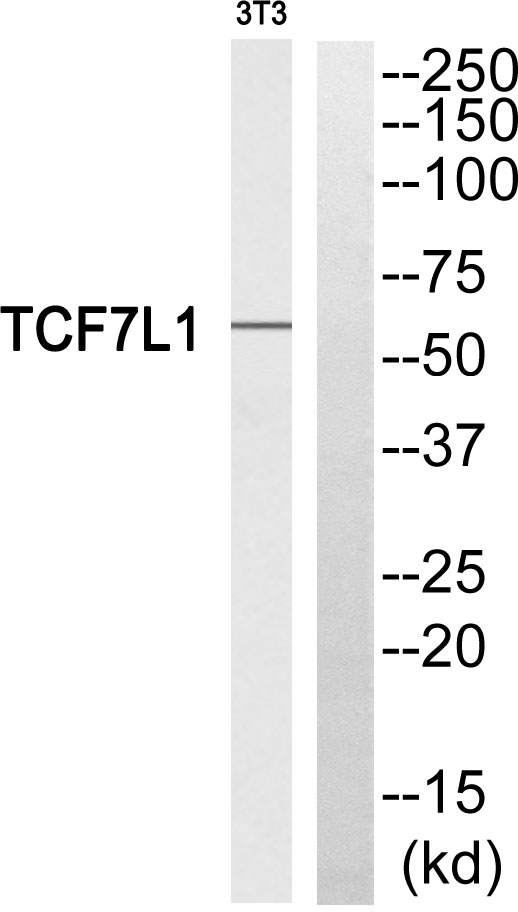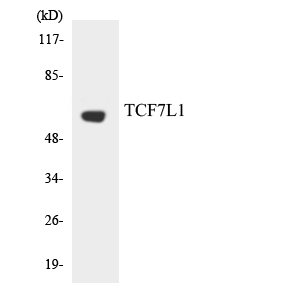TCF-3 Polyclonal Antibody
- Catalog No.:YT4578
- Applications:WB;ELISA
- Reactivity:Human;Mouse
- Target:
- TCF-3
- Fields:
- >>Wnt signaling pathway;>>Hippo signaling pathway;>>Adherens junction;>>Melanogenesis;>>Cushing syndrome;>>Alcoholic liver disease;>>Salmonella infection;>>Human papillomavirus infection;>>Kaposi sarcoma-associated herpesvirus infection;>>Pathways in cancer;>>Colorectal cancer;>>Endometrial cancer;>>Prostate cancer;>>Thyroid cancer;>>Basal cell carcinoma;>>Acute myeloid leukemia;>>Breast cancer;>>Hepatocellular carcinoma;>>Gastric cancer;>>Arrhythmogenic right ventricular cardiomyopathy
- Gene Name:
- TCF7L1
- Protein Name:
- Transcription factor 7-like 1
- Human Gene Id:
- 83439
- Human Swiss Prot No:
- Q9HCS4
- Mouse Gene Id:
- 21415
- Mouse Swiss Prot No:
- Q9Z1J1
- Immunogen:
- The antiserum was produced against synthesized peptide derived from human TCF7L1. AA range:321-370
- Specificity:
- TCF-3 Polyclonal Antibody detects endogenous levels of TCF-3 protein.
- Formulation:
- Liquid in PBS containing 50% glycerol, 0.5% BSA and 0.02% sodium azide.
- Source:
- Polyclonal, Rabbit,IgG
- Dilution:
- WB 1:500 - 1:2000. ELISA: 1:10000. Not yet tested in other applications.
- Purification:
- The antibody was affinity-purified from rabbit antiserum by affinity-chromatography using epitope-specific immunogen.
- Concentration:
- 1 mg/ml
- Storage Stability:
- -15°C to -25°C/1 year(Do not lower than -25°C)
- Other Name:
- TCF7L1;TCF3;Transcription factor 7-like 1;HMG box transcription factor 3;TCF-3
- Observed Band(KD):
- 63kD
- Background:
- This gene encodes a member of the T cell factor/lymphoid enhancer factor family of transcription factors. These transcription factors are activated by beta catenin, mediate the Wnt signaling pathway and are antagonized by the transforming growth factor beta signaling pathway. The encoded protein contains a high mobility group-box DNA binding domain and participates in the regulation of cell cycle genes and cellular senescence. [provided by RefSeq, Nov 2010],
- Function:
- domain:The putative Groucho interaction domain between the N-terminal CTNNB1 binding domain and the HMG-box is necessary for repression of the transactivation mediated by TCF7L1 and CTNNB1.,function:Participates in the Wnt signaling pathway. Binds to DNA and acts as a repressor in the absence of CTNNB1, and as an activator in its presence. Necessary for the terminal differentiation of epidermal cells, the formation of keratohyalin granules and the development of the barrier function of the epidermis (By similarity). Down-regulates NQO1, leading to increased mitomycin c resistance.,similarity:Belongs to the TCF/LEF family.,similarity:Contains 1 HMG box DNA-binding domain.,subunit:Binds the armadillo repeat of CTNNB1 and forms a stable complex.,tissue specificity:Detected in hair follicles and skin keratinocytes, and at lower levels in stomach epithelium.,
- Subcellular Location:
- Nucleus.
- Expression:
- Detected in hair follicles and skin keratinocytes, and at lower levels in stomach epithelium.
- June 19-2018
- WESTERN IMMUNOBLOTTING PROTOCOL
- June 19-2018
- IMMUNOHISTOCHEMISTRY-PARAFFIN PROTOCOL
- June 19-2018
- IMMUNOFLUORESCENCE PROTOCOL
- September 08-2020
- FLOW-CYTOMEYRT-PROTOCOL
- May 20-2022
- Cell-Based ELISA│解您多样本WB检测之困扰
- July 13-2018
- CELL-BASED-ELISA-PROTOCOL-FOR-ACETYL-PROTEIN
- July 13-2018
- CELL-BASED-ELISA-PROTOCOL-FOR-PHOSPHO-PROTEIN
- July 13-2018
- Antibody-FAQs
- Products Images

- Western blot analysis of TCF7L1 Antibody. The lane on the right is blocked with the TCF7L1 peptide.

- Western blot analysis of the lysates from HUVECcells using TCF7L1 antibody.



